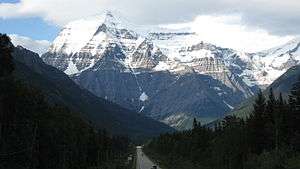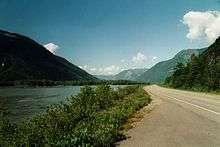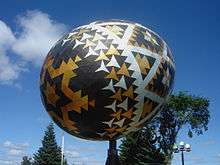Yellowhead Highway
The Yellowhead Highway, part of the Trans-Canada Highway system, is in western Canada (the Prairies and British Columbia). It is not the Trans-Canada mainline (which originates in Victoria in the west) but an alternate, northern route through Edmonton with Prince Rupert as its western endpoint.

- This article is an itinerary.
Understand
The 2,660 km (1,650 mi) Yellowhead Highway is one of multiple highways which compose the Trans-Canada Highway system; in all four western provinces (BC, AB, SK, MB) it is numbered as provincial Highway 16. The route leads through remote and sparsely-populated areas due to its more northern alignment, including many native First Nation communities; in BC it is known as the Highway of Tears due to a number of hitchhikers missing or dead over the years.
Prince George is accessible from the BC Lower Mainland via BC Highway 97 (which extends US 97) but further west the route is isolated. In Terrace, the only other highway (BC 37) runs north through mountainous terrain to the Alaska Highway in the Yukon; in Prince Rupert, the only access is by coastal ferry, by air or by following the Yellowhead Highway's path by road or rail. No road follows the rugged BC coastline north from Powell River to Prince Rupert.
Further east, the Yellowhead Highway passes through two large cities: Edmonton (metro population 1.1 million), Saskatoon (population 250,000), and Winnipeg (population 700,000). While this itinerary describes travel by road, it is possible to make the same trip by rail: Via Rail runs a two-day Jasper-Prince Rupert train from which one may transfer in Jasper village (in Jasper National Park) to the main Vancouver-Toronto train, The Canadian.
Prepare

This itinerary is based on travel by motorcar. There is limited access by public transit:
- By train: VIA runs from Prince Rupert to Jasper. From there, one can take The Canadian onward to Winnipeg.
- By bus: While Greyhound Canada withdrew from western Canada in 2018, much of the Yellowhead highway remains accessible via a string of regional carriers. BC Transit runs Prince Rupert-Prince George and Prince George-Valemont. There's a 100 km (62 mi) gap between Tête Jaune Cache (near Valemont) and Jasper. Sun Dog runs from Jasper to Edmonton; Cold Shot runs Jasper-Edmonton and Edmonton-Lloydminster, connecting to KCTI's shuttlebus to Saskatoon. Rider Express continues from Edmonton to Winnipeg.
This is a northern route which leads through isolated communities and through the Rocky Mountains in British Columbia. It requires at least thirty-two hours of continuous driving and road conditions may be treacherous in winter. Be sure that your vehicle is in top mechanical condition; do not set out on this route in winter without snow tires and emergency equipment for winter driving.
Get in
While this route may be taken from either endpoint (Prince Rupert or Portage la Prairie), incorporated as part of a longer Trans-Canada trip, or joined at any intermediate point (such as by taking Alberta Highway 2 from Calgary to Edmonton), this itinerary describes a trip from west to east, starting in Prince Rupert BC and joining the Trans-Canada mainline in Manitoba.
See Trans-Canada Highway for a description of the main route.
Prince Rupert, as BC's northernmost seaport, is accessible by ferry from Port Hardy, from Alaska or from Haida Gwaii (the Queen Charlotte Islands). BC Ferries operates the Northern Expedition, a car ferry from Port Hardy on north Vancouver Island which costs $450/car + $200/passenger for a 520km (310 mile), seventeen-hour journey.
The distance from Prince Rupert to Ketchikan, Alaska by sea is less than 200 km (120 mi); Hyder is about 320 km (200 mi) from the Yellowhead Highway by road.
Go

🌍 Haida Gwaii, formerly known the as the Queen Charlotte Islands and westernmost point on the Trans-Canada Highway system, the sparsley populated islands are located 40-65 km off the coast of British Columbia and accessablie via BC Ferries.
🌍 Prince Rupert, the westernmost point on the Trans-Canada Highway system, is a small port city of 13000 people, many of them natives. It serves as a connection point for BC Ferries, Alaska Marine Highway System, Air Canada, Hawkair and seaplane operators to offload passengers and cargo onto road and rail, but also hosts various museums (railway, First Nations, canneries) and provides a port of call to cruise ships.
Head east through 🌍 Terrace (a small city with 11000 people, including many Kitselas natives), 🌍 Smithers (a pop. 5800 alpine village with lakes and a ski hill), 🌍 Vanderhoof (a farming town on one of the few flatlands in the area), 🌍 Prince George (pop 72000, a highway crossroads and forestry community on the Nechako River), McBride, Tete Jaune Cache and Mount Robson Provincial Park, British Columbia. While the mountain peak itself (Mount Robson, 3954 metres) is not for the novice climber, the park offers hiking trails, fishing and camping. The route then crosses into Alberta as parkland.
A UNESCO World Heritage Site, Jasper National Park covers 10,878 square kilometres (4200 square miles), containing more than 1200 kilometres (660 miles) of hiking trails, glaciers, mountains, valleys, meadows, forests and rivers. From 🌍 Jasper and 🌍 Hinton, the road leads through Edson, Wabamun, Stony Plain and Spruce Grove to 🌍 Edmonton, the provincial capital.
The northernmost city of at least one million people in North America, Edmonton was initially built around the fur trade in 1795; it became an oil boom town after prospectors struck black gold in nearby Leduc County in 1947. The city is home to the University of Alberta and a military base, CFB Edmonton.

The road continues east through 🌍 Elk Island National Park (aspen wilderness parkland and protected wildlife, less than an hour from the sprawling city) and 🌍 Vegreville (an agricultural community with strong Ukrainian immigrant heritage, home of the world's largest Ukrainian Easter egg).
It crosses into Saskatchewan at the provincially-divided city of 🌍 Lloydminster, where the border runs right down 50th Avenue (Meridian Avenue) in the centre of town. Unlike other twin cities (such as Ottawa-Gatineau or Windsor-Detroit), Lloydminster is legally one city (pop 30000) despite being in two provinces. Its primary industries are petroleum refining and agriculture.
The highway continues through 🌍 North Battleford (a city of 15,000 with a ski area and a provincial park) to 🌍 Saskatoon (the province's largest city, with over a quarter-million people) and 🌍 Yorkton (a population 15000 agricultural community, home of the Yorkton Film Festival) before crossing the Manitoba border and ending at the Trans-Canada Highway mainline near 🌍 Portage la Prairie (population 13,000). Portage la Prairie was built around 1838 fur trade post Fort La Reine (now a 25-building museum); canoes were carried overland from Lake Manitoba to the Assiniboine River. The city became a railway crossroads; between 1942-1992, a military base trained fighter pilots. As passengers left the rails to take to the open road, Trans-Canada Highway 1 followed the Canadian Pacific rails, while Yellowhead 16 followed the Canadian National line west to Prince Rupert. While Trans-Canada Highway 16 ends at Portage La Prairie, the Yellowhead Highway follows Trans-Canada Highway 1 east to 🌍 Winnipeg, where it ends in downtown at historic Portage and Main.
Stay safe
Cellular telephone coverage in the mountains is sporadic, with countless dead spots in each valley. A long stretch of British Columbia highway between Prince George and the Alberta border has no coverage from any carrier. Do not assume that roadside assistance will be just a telephone call away when needed. In adverse winter conditions, portions of the road may be closed in order to clear snow or due to avalanche risk.
This is sparsely-populated country and not without risks when hitchhiking. Use public transit as an alternative, if it is available.
Go next
To continue further east, take the Trans-Canada Highway mainline (Highway 1) through Winnipeg to Ontario.